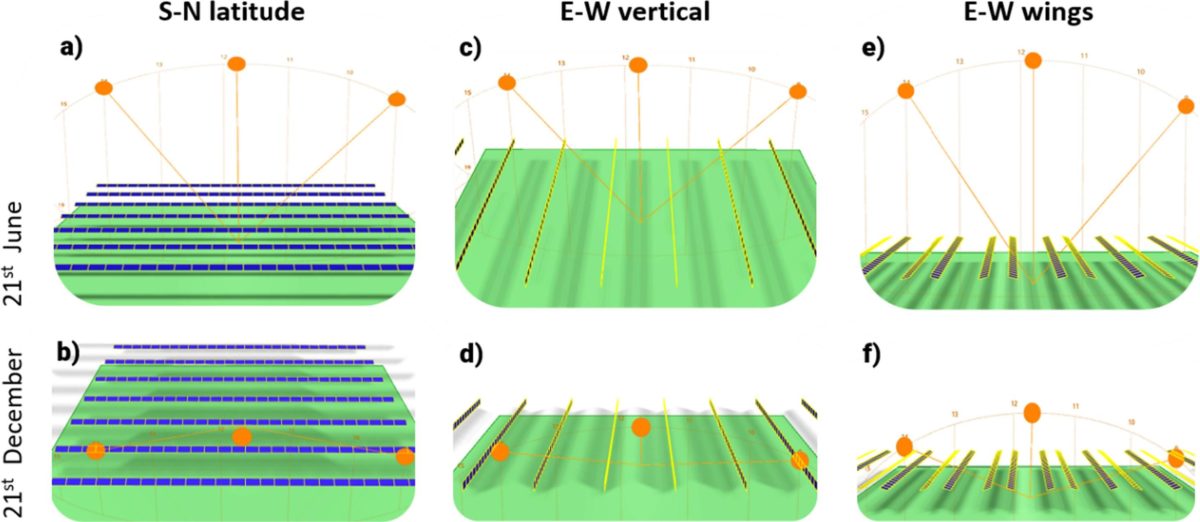Researchers at Delft University of Technology in the Netherlands have developed an optimized array topology for medium-to-large-scale agrivoltaic projects based on bifacial solar modules.
“Bifacial modules are not recommended for all agrivoltaic projects worldwide,” researcher Odysseas Alexandros Katsikogiannis told pv magazine. “The benefits of bifacial PV arrays are most prominent in stilt mounted projects, where modules are elevated considerably off the ground at over 2 m, thus allowing plenty of light to be absorbed by the rear PV side as well. Moreover, when light demanding crops are cultivated, the amount of irradiance incident on the ground should be abundant which synergizes well with bifacial PV.”
For shade-tolerant crop species such as mushrooms, monofacial panels are preferable as intense shading is required, he added. Furthermore, as installations move closer to the equator the advantages of bifacial agrivoltaic projects diminish, especially for crops that can tolerate shade.
In the paper “Integration of bifacial photovoltaics in agrivoltaic systems: A synergistic design approach,” published in Applied Energy, Katsikogiannis and his colleagues simulated three different topologies of fixed bifacial agrivoltaic arrays, which were labeled as S-N facing, E-W wings, and E-W vertical, with the first one being south-oriented and the other two having an east-west configuration. “Based on our simulations, we can claim that E-W facing APV arrays offer a more homogeneous light distribution on the ground, which in turn allows uniform growth conditions for crops,” the scientists explained. “On the other hand, south-facing topologies are recommended for cultivation during summer as they cast thick shadows and are associated with an increased electricity generation.”
He also explained that the E-W orientation in combination with extended translucent covers may be a better option for high-value crops, like berries, and organic farming as it can provide protection from harmful weather conditions such as hail. In this way, the added cost associated with the extended covers could be offset by the increased revenue provided by these crops.
The researchers simulated the performance of each project topology and they found the S-N facing bifacial array was able to produce 39% more electricity than its monofacial counterpart, while the bifacial E-W wings and E-W vertical arrays had a higher yield of 18 and 13%, respectively. “E-W vertical is more appropriate for permanent crop species, while S-N facing necessitates the cultivation of shade-tolerant crops during summer as electricity generation is prioritized,” the paper reads. “The E-W wings topology combines the best of both; light is distributed homogeneously, and crops are effectively shaded at noon.”
“The E-W wings topology, however, is not applicable to all kinds of agrivoltaic projects,” Katsikogiannis further explained. “Lastly, by adjusting the cell spacing and subsequently module transparency the rate of photosynthesis under shade increased significantly, consequently promoting crop growth even under the climate of Boston, in the United States. Ultimately, this customized topology will outshine the rest when permanent, high-value crops are cultivated, especially in climates with low light conditions and/or harmful weather events.”
The scientist also highlighted that the calculation of albedo can be complex, particularly for agrivoltaics. “Normally, the albedo is altered by the optical properties of the surrounding landscape and the PV configuration adopted,” the research group stated. “However, in agrivoltaics, ground albedo will also be crop-specific, thus intensifying seasonal variation.” According to its findings, the reflectance of plants is higher than that of soil, thus we expect an increase of the overall albedo depending on crop species, crop phenological stage, and planting density. “In addition, crop architecture — canopy height, leaf area index (LAI), and leaf arrangement — will greatly influence the amount of light reflected off the ground,” it also emphasized. LAI indicates the density of leaves in the plant's canopy, and it is thus directly relevant to the amount of light intercepted by the crop and subsequently reflected back.
This content is protected by copyright and may not be reused. If you want to cooperate with us and would like to reuse some of our content, please contact: editors@pv-magazine.com.




By submitting this form you agree to pv magazine using your data for the purposes of publishing your comment.
Your personal data will only be disclosed or otherwise transmitted to third parties for the purposes of spam filtering or if this is necessary for technical maintenance of the website. Any other transfer to third parties will not take place unless this is justified on the basis of applicable data protection regulations or if pv magazine is legally obliged to do so.
You may revoke this consent at any time with effect for the future, in which case your personal data will be deleted immediately. Otherwise, your data will be deleted if pv magazine has processed your request or the purpose of data storage is fulfilled.
Further information on data privacy can be found in our Data Protection Policy.